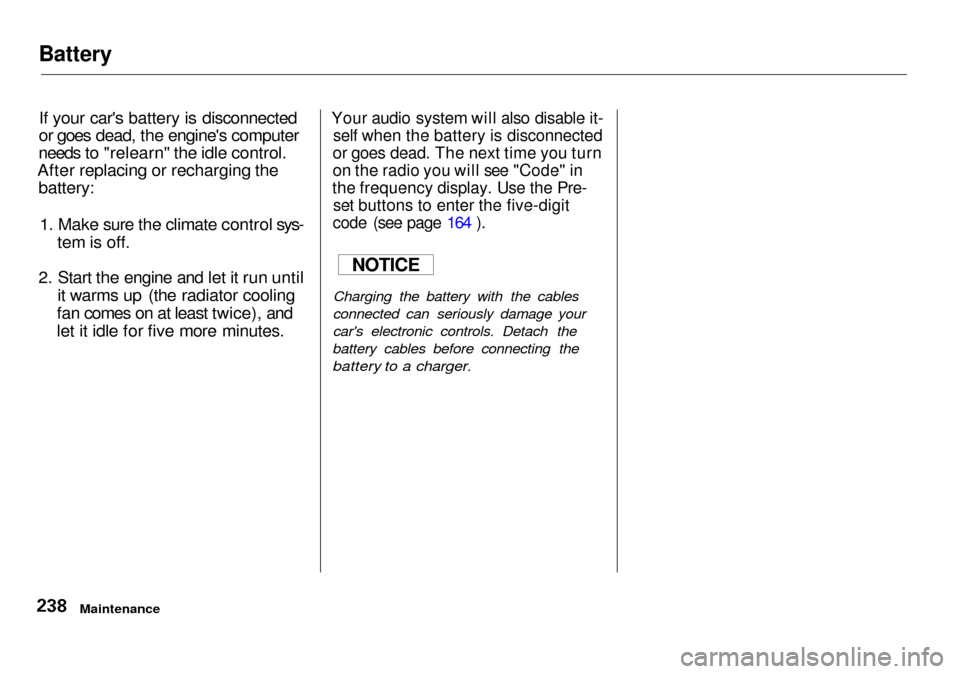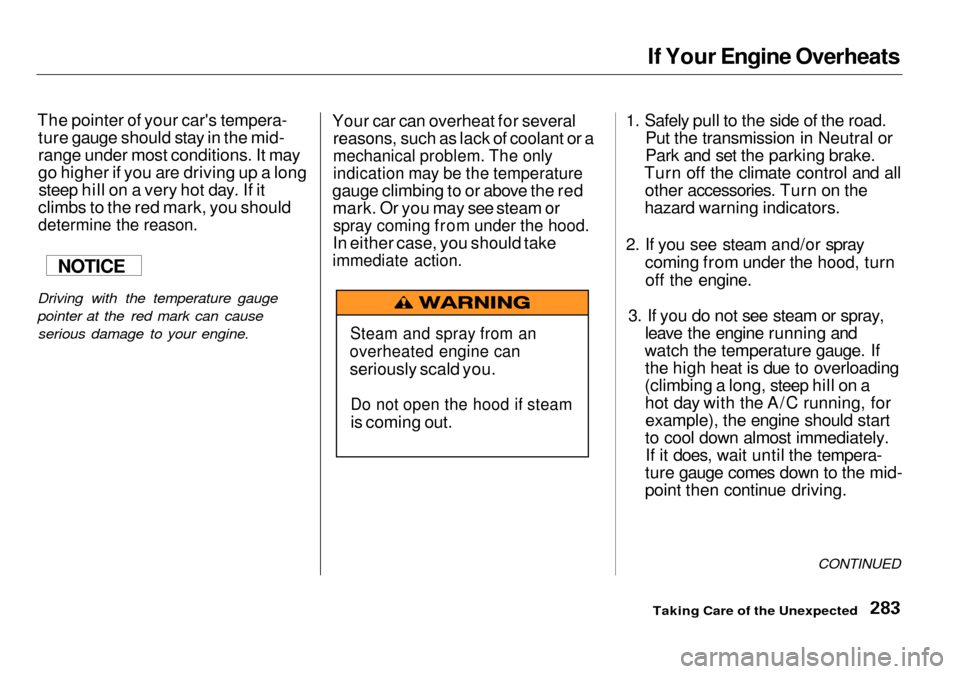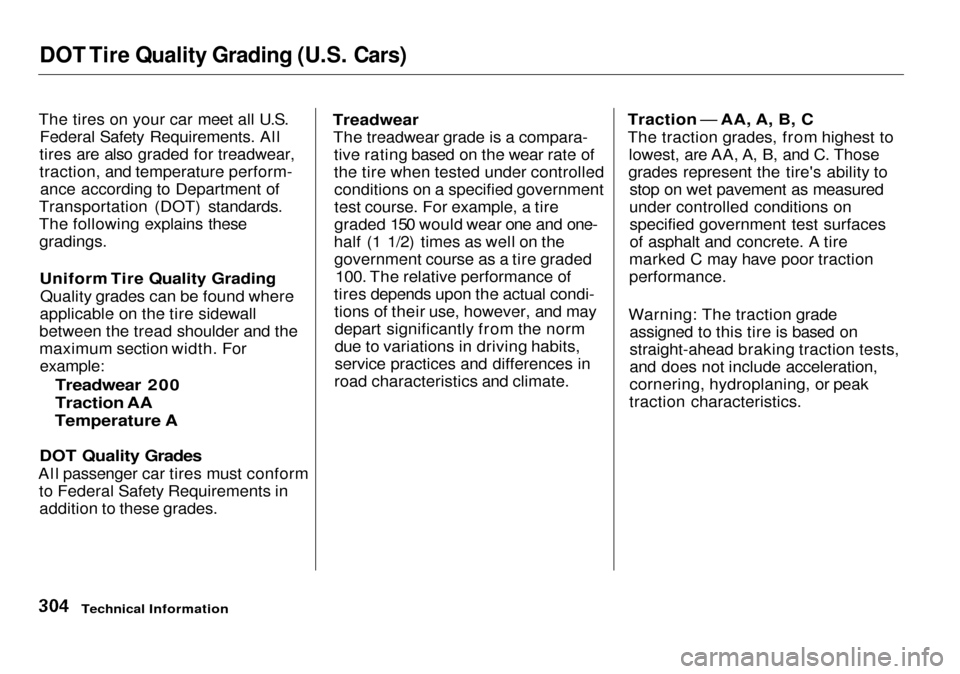climate control Acura RL 2001 3.5 Owner's Guide
[x] Cancel search | Manufacturer: ACURA, Model Year: 2001, Model line: RL, Model: Acura RL 2001Pages: 333, PDF Size: 4.28 MB
Page 226 of 333

Cooling System
Replacing Engine Coolant
The cooling system should be completely drained and refilled with
new coolant according to the time
and distance recommendations in
the maintenance schedule. Only use Honda All Season Antifreeze/Coolant Type 2. Use of any non-
Honda coolant or plain water can
result in corrosion and deposits in
the cooling system.
Draining the coolant requires access
to the underside of the car. Unless
you have the tools and knowledge,
you should have this maintenance done by a skilled mechanic.
1. Turn the ignition ON (II). Turn
the heater temperature control
dial to maximum heat (climate
control to 90°F/32°C). Turn off
the ignition. Open the hood. Make
sure the engine and radiator are
cool to the touch.
2. Remove the radiator cap.
3. Loosen the drain plug on the
bottom of the radiator. The
coolant will come out through the
hole in the splash cover.
CONTINUED
Maintenance
DRAIN PLUG
Page 241 of 333

Battery
If your car's battery is disconnected
or goes dead, the engine's computer
needs to "relearn" the idle control.
After replacing or recharging the
battery:
1. Make sure the climate control sys-
tem is off.
2. Start the engine and let it run until
it warms up (the radiator cooling
fan comes on at least twice), and
let it idle for five more minutes.
Your audio system will also disable it-
self when the battery is disconnected
or goes dead. The next time you turn
on the radio you will see "Code" in
the frequency display. Use the Pre- set buttons to enter the five-digit
code (see page 164 ).
Charging the battery with the cables
connected can seriously damage your
car's electronic controls. Detach the
battery cables before connecting the
battery to a charger.
Maintenance
NOTICE
Page 245 of 333

Air Conditioning Filter, Drive Belts
Air Conditioning Filter The air conditioning filter removespollen and dust that is brought in
from the outside through the climate control system.
This filter should be replaced every 30,000 miles (48,000 km) under nor-
mal conditions. It should be replaced
every 15,000 miles (24,000 km) if youdrive primarily in urban areas that
have high concentrations of soot in
the air from industry and diesel-pow- ered vehicles. Replace it more often
if air flow from the climate control system becomes less than usual.
Have the air conditioning filter re-
placed by your Acura dealer. Drive Belts
The belts should have the following
"play" or deflection.
Alternator belt:
0.37 — 0.45 in (9.5 — 11.5 mm)
Compressor belt:
0.31 — 0.43 in (8.0 — 11.0 mm)
Power steering belt:
0.41 — 0.49 in (10.5 — 12.5 mm)
If you see signs of wear or looseness,
have your dealer adjust or replace
the belts.
Maintenance
Check the condition of the three
drive belts. Examine the edges of
each belt for cracks or fraying.
Check the tension of each belt by
pushing on it with your thumb midway between the pulleys.
ALTERNATOR BELT
POWER STEERING BELT
COMPRESSOR BELT
Page 284 of 333

Jump Starting
If a battery sits in extreme cold, the electrolyte inside can freeze.
Attempting to jump start with a frozen battery can cause it to rupture.
2. Turn off all the electrical acces- sories: climate control, stereo
system, lights, etc.
Put the transmission in Neutral or
Park and set the parking brake.
3. Connect one jumper cable to thepositive ( + ) terminal on your
Acura's battery. Connect the other end to the positive (
+ ) terminal
on the booster battery. 4. Connect the second jumper cable
to the negative ( — ) terminal on
the booster battery. Connect theother end to the ground wire on
the right side of the engine as shown. Do not connect this jumper
cable to any other part of the
engine.
5. If the booster battery is in another vehicle, have an assistant startthat vehicle and run it at a fast idle.
Taking Care of the Unexpected
CONTINUED
NOTICE
Page 286 of 333

If Your Engine Overheats
The pointer of your car's tempera- ture gauge should stay in the mid-
range under most conditions. It may
go higher if you are driving up a longsteep hill on a very hot day. If it
climbs to the red mark, you should
determine the reason.
Driving with the temperature gauge
pointer at the red mark can cause
serious damage to your engine.
Your car can overheat for several
reasons, such as lack of coolant or a
mechanical problem. The only
indication may be the temperature
gauge climbing to or above the red mark. Or you may see steam or
spray coming from under the hood.
In either case, you should take
immediate action.
1. Safely pull to the side of the road.
Put the transmission in Neutral or
Park and set the parking brake.
Turn off the climate control and all other accessories. Turn on the
hazard warning indicators.
2. If you see steam and/or spray coming from under the hood, turnoff the engine.
3. If you do not see steam or spray, leave the engine running and
watch the temperature gauge. If the high heat is due to overloading
(climbing a long, steep hill on a hot day with the A/C running, forexample), the engine should start
to cool down almost immediately. If it does, wait until the tempera-
ture gauge comes down to the mid-
point then continue driving.
CONTINUED
Taking Care of the Unexpected
NOTICE
Steam and spray from an
overheated engine can
seriously scald you.
Do not open the hood if steam
is coming out.
Page 287 of 333

If Your Engine Overheats
4. If the temperature gauge stays at the red mark, turn off the engine.
5. Wait until you see no more signs of steam or spray, then open the
hood.
6. Look for any obvious coolant leaks, such as a split radiator hose.
Everything is still extremely hot,so use caution. If you find a leak, it
must be repaired before you
continue driving (see Emergency
Towing on page 296 ).
7. If you don't find an obvious leak, check the coolant level in the
radiator reserve tank (see page172 ). If the level is below the
MIN mark, add coolant to halfway
between the MIN and MAX marks.
8. If there was no coolant in the reserve tank, you may also have toadd coolant to the radiator. Let the
engine cool down until the pointer reaches the middle of the tempera-
ture gauge, or lower, before check- ing the radiator.
9. Using gloves or a large heavy cloth, turn the radiator capcounterclockwise, without pushing
down, to the first stop. This
releases any remaining pressure in
the cooling system. After the
pressure releases, push down on
the cap and turn it until it comes off. 10.Start the engine and set the
temperature control dial tomaximum (climate control to
FULL AUTO at 90°F/32°C). Add
coolant to the radiator up to the
base of the filler neck. If you do not have the proper coolant
mixture available, you can add
plain water. Remember to have
the cooling system drained andrefilled with the proper mixture assoon as you can.
11. Put the radiator cap back on tightly. Run the engine and watch
the temperature gauge. If it goes
back to the red mark, the engine
needs repair. (See Emergency
Towing on page 296 .)
12.If the temperature stays normal, check the coolant level in the
radiator reserve tank. If it has
gone down, add coolant to the MAX mark. Put the cap back on
tightly.
Taking Care of the Unexpected
Removing the radiator cap
while the engine is hot can
cause the coolant to spray out, seriously scalding you.
Always let the engine and
radiator cool down before
removing the radiator cap.
Page 289 of 333

Charging System Indicator
This indicator should come on when the ignition switch is ON (II), and goout after the engine starts. If it
comes on brightly when the engine
is running, it indicates that the charging system has stopped
charging the battery. Immediately turn off all electrical
accessories: radio, climate control,
rear defogger, cruise control, etc.
Try not to use other electrically- operated controls such as the power
windows. Keep the engine running and take extra care not to stall it.
Starting the engine will discharge
the battery rapidly. By eliminating as much of the
electrical load as possible, you can
drive several miles (kilometers)
before the battery is too discharged
to keep the engine running. Drive to a service station or garage where
you can get technical assistance.
Taking Care of the Unexpected
CHARGING SYSTEM INDICATOR
Page 307 of 333

DOT Tire Quality Grading (U.S. Cars)
The tires on your car meet all U.S. Federal Safety Requirements. All
tires are also graded for treadwear,
traction, and temperature perform- ance according to Department of
Transportation (DOT) standards.
The following explains these gradings.
Uniform Tire Quality Grading
Quality grades can be found where
applicable on the tire sidewall
between the tread shoulder and the
maximum section width. For
example:
Treadwear 200
Traction AA
Temperature A
DOT Quality Grades
All passenger car tires must conform to Federal Safety Requirements inaddition to these grades.
Treadwear
The treadwear grade is a compara- tive rating based on the wear rate of
the tire when tested under controlledconditions on a specified government
test course. For example, a tire
graded 150 would wear one and one-
half (1 1/2) times as well on the government course as a tire graded 100. The relative performance of
tires depends upon the actual condi- tions of their use, however, and maydepart significantly from the norm
due to variations in driving habits,
service practices and differences in
road characteristics and climate.
Traction — AA, A, B, C
The traction grades, from highest to
lowest, are AA, A, B, and C. Those
grades represent the tire's ability to stop on wet pavement as measured
under controlled conditions on specified government test surfaces
of asphalt and concrete. A tire
marked C may have poor traction
performance.
Warning: The traction grade assigned to this tire is based on
straight-ahead braking traction tests,
and does not include acceleration,
cornering, hydroplaning, or peak
traction characteristics.
Technical Information
Page 311 of 333

Emissions Controls
The burning of gasoline in your car's engine produces several byproducts.
Some of these are carbon monoxide (CO), oxides of nitrogen (NOx) and
hydrocarbons (HC). Gasoline evaporating from the tank also
produces hydrocarbons. Controlling
the production of NOx, CO, and HC is important to the environment.
Under certain conditions of sunlight
and climate, NOx and HC react to
form photochemical "smog." Carbon monoxide does not contribute tosmog creation, but it is a poisonous
gas.
The Clean Air Act
The United States Clean Air Act*
sets standards for automobile
emissions. It also requires that
automobile manufacturers explain to owners how their emissions controls
work and what to do to maintain
them. This section summarizes how the emissions controls work.
Scheduled maintenance is on page 208.
* In Canada, Acura vehicles comply
with the Canadian Motor Vehicle Safety Standards (CMVSS) for
Emissions valid at the time they are
manufactured.
Crankcase Emissions Control
System
Your car has a Positive Crankcase
Ventilation System. This keeps gasses that build up in the engine'scrankcase from going into the
atmosphere. The Positive Crankcase
Ventilation valve routes them from the crankcase back to the intake
manifold. They are then drawn into
the engine and burned.
Evaporative Emissions Control
System
As gasoline evaporates in the fuel tank, an evaporative emissionscontrol canister filled with charcoaladsorbs the vapor. It is stored in this
canister while the engine is off. After
the engine is started and warmed up,
the vapor is drawn into the engine and burned during driving.
Onboard Refueling Vapor
Recovery
The Onboard Refueling Vapor Recovery (ORVR) system captures
the fuel vapors during refueling. The
vapors are adsorbed in a canister filled with activated carbon. Whiledriving, the fuel vapors are drawn
into the engine and burned off.
Technical Information
Page 324 of 333

Index
Accessories and Modifications.... 174 Accessories................................. 174
Additional Safety Precautions.. 175Modifications............................. 175
ACCESSORY (Ignition Key
Position)........................................ 80
Accessory Power Socket.............. 115
Additives, Engine Oil..................... 218
Airbag (SRS).......................... 9, 43, 45
Air Cleaner Element...................... 231
Air Conditioning Filter.................. 242
Air Conditioning System............... 122 Maintenance............................... 241
Usage..................................124, 129
Air Outlets (Vents)........................ 122
Air Pressure, Tires........................ 243
Alarm, Anti-theft............................ 164
Alcohol in Gasoline........................ 306
Aluminum Wheels, Cleaning........ 265
Antifreeze....................................... 221
Anti-lock Brakes (ABS) Indicator................................ 56, 189Operation.................................... 188
Anti-theft, Audio System............... 164
Anti-theft Steering Column
Lock...............................................80
Anti-theft System........................... 165
Appearance Care........................... 263
Armrest............................................. 97
Ashtrays.......................................... 117
Audio Controls, Remote................ 163
Audio System................................. 136
Automatic Climate Control
System......................................... 122
Automatic Lighting.......................... 64
Automatic Seat Belt Tensioners.................................... 41
Automatic Speed Control................ 73
Automatic Transmission............... 182
Capacity, Fluid........................... 302
Checking Fluid Level................228
Shifting........................................ 182
Shift Lever Position Indicator.. 182
Shift Lever Positions................. 182
Shift Lock Release..................... 185 Battery
Charging SystemIndicator............................ 54, 286
Jump Starting............................. 280 Maintenance............................... 236
Specifications............................. 303
Before Driving............................... 167
Belts, Seat..................................... 8, 40
Beverage Holder............................ 112
Body Repair.................................... 270
Brakes
Anti-lock System (ABS)............ 188
Break-in, New Linings .............. 168
Bulb Replacement..................... 256
Fluid............................................229
Parking........................................ 109
System Indicator.................. 54, 289
Wear Indicators......................... 187
Braking System.............................. 187
Break-in, New Car......................... 168
Brightness Control, Instruments... 66
Brights, Headlights......................... 63
CONTINUED